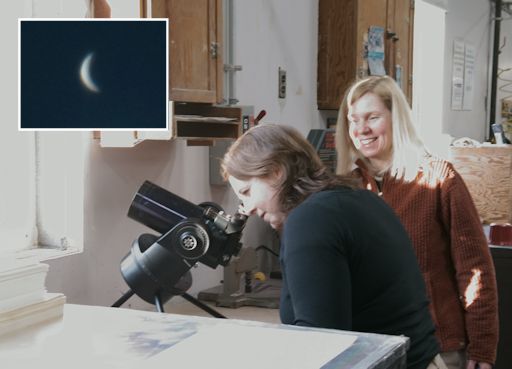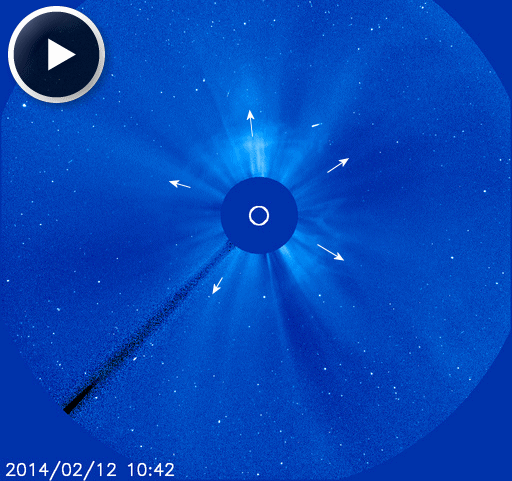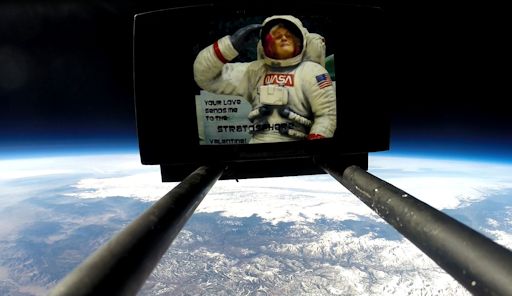Spaceweather.com - 2/13/14
SOLAR ACTIVITY: Solar activity is at moderately high levels as five M-class solar flares and multiple CMEs were observed over the past 24 hours. The primary source is active sunspot AR1974, which has a 'beta-gamma-delta' magnetic field that harbors energy for strong explosions. NOAA forecasters estimate a 60% chance of M-flares and a 10% chance of X-flares on Feb. 13th. Solar flare alerts: text, voice
INCOMING CMES COULD SPARK VALENTINE'S LIGHTS: On Feb. 12th, an M-class exlosion in the magnetic canopy of sunspot AR1974 hurled a faint CME almost directly toward Earth. This SOHO coronagraph movie shows the cloud racing away from the sun:
This CME is following close on the heels of two others that left the sun on Feb. 11th. As CMEs go, all of them are relatively minor. Taken together, however, the three CMEs hitting Earth's magnetic field in quick succession could spark moderately strong geomagnetic activity on Feb. 14th and 15th. High-latitude sky watchers should be alert for auroras on Valentine's Day. Aurora alerts: text, voice
Realtime Space Weather Photo Gallery
HAPPY VALENTINE'S DAY FROM THE STRATOSPHERE: Helium is not free. That's why the student scientists of Earth to Sky Calculus occasionally fly commercial payloads onboard their suborbital balloons. The profits fund space weather experiments in the stratosphere. Yesterday, the team flew a batch of Valentine's Cards to the edge of space. Spaceweather reader Shiree Schade was one of the customers:
"Best Valentine's card...EVER!" she says. "Not only will my valentine cherish the image, but I can't wait to start bragging to my friends that I'VE been to the stratosphere."
The student group makes regular flights to the stratosphere to measure radiation and ozone during periods of stormy space weather. If you would like to support their work with, say, a birthday card or Mother's Day greeting, contact Dr. Tony Phillips to book passage. The cost is only $49.95.
INDOOR STAR PARTY: For amateur astronomers, winter can be an uncomfortable time. It's hard to concentrate on the stars above when you are freezing. Lawrence Garrett of Queen City Printers In Burlington, Vermont, has a solution to this problem: "Hold your star party indoors." Seriously. "For the past two months I have been holding indoor press room star parties," he says. "Using a solar filter, we have watched active region 1944 round the Sun. And we have been enjoying good views of Venus, which is currently a slender crescent. " Here are two of his colleagues taking a look at the second planet through his Meade 90mm ETX:

"Even with window glass and slight haze, the sight of Venus was beyond my greatest expectations. Others with small telescopes might find these inside star parties just as good as those outside this time of year, and introduce Venus, and perhaps the Sun and Moon to co-workers, while staying warm in the process!"
How do you find Venus through the window in broad daylight? Garrett offers this advice:
"Venus is easy to see right before I start work in strong twilight. The real trick is to do polar alignment indoors so the telescope can track Venus. Its easy with the ETX if you know where the North Pole is. I start tracking on Venus for a few minutes, and then see how it has moved away from the center of the eyepiece view. I then move the whole telescope to place Venus back in the center and it tracks perfectly after that."
Realtime Space Weather Photo Gallery
| All Sky Fireball Network |
Every night, a network of NASA all-sky cameras scans the skies above the United States for meteoritic fireballs. Automated software maintained by NASA's Meteoroid Environment Office calculates their orbits, velocity, penetration depth in Earth's atmosphere and many other characteristics. Daily results are presented here on Spaceweather.com.
On Feb. 13, 2014, the network reported 0 fireballs.
(winter weather)
On Feb. 12, 2014, the network reported 6 fireballs.
Solar wind
speed: 329.9 km/sec
density: 1.0 protons/cm3
explanation | more data
Updated: Today at 0337 UT
X-ray Solar Flares
6-hr max: C6 1955 UT Feb13
24-hr: M1 0140 UT Feb13
explanation | more data
Updated: Today at: 2359 UT ![]()



